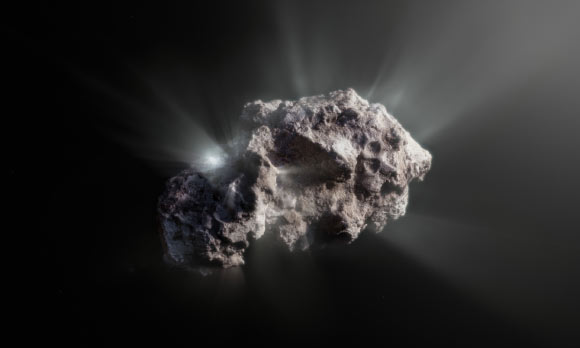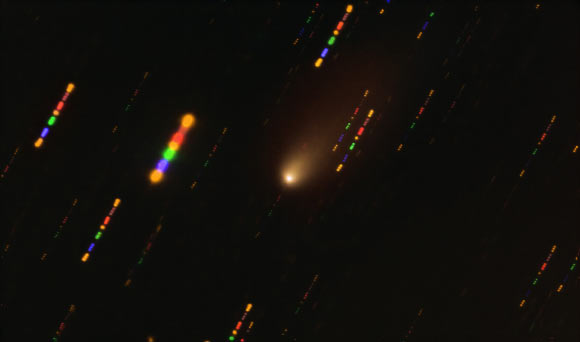Two teams of astronomers have performed polarimetric observations of 2I/Borisov, the first active extrasolar comet ever detected in our Solar System, using ESO’s Very Large Telescope (VLT) to derive the physical characteristics of its coma dust particles; they’ve also obtained high-resolution interferometric observations of 2I/Borisov with the Atacama Large Millimeter/submillimeter Array (ALMA) and multi-color optical observations with VLT to gain a comprehensive understanding of its dust properties.

An artist’s impression of what the surface of the interstellar comet 2I/Borisov might look like. Image credit: ESO / M. Kormesser.
2I/Borisov, also known as C/2019 Q4, was discovered on August 30, 2019 by Gennady Borisov, an amateur astronomer from Crimea, Ukraine.
Its orbital eccentricity shows that the object is not gravitationally bound to the Solar System, making it the first unambiguous case of a comet arriving from interstellar space.
This is only the second recognized case of a small body entering the Solar System from interstellar space.
The first such case, namely that of 1I/‘Oumuamua, discovered on October 18, 2017, by the Pan-STARRS 1 telescope, was that of an apparently asteroidal body, lacking detectable signs of cometary activity.
In contrast, 2I/Borisov exhibited a coma, and its apparition provided a unique opportunity to glean information about a body apparently similar to comets in our Solar System, but otherwise unrelated to them.
“2I/Borisov could represent the first truly pristine comet ever observed,” said Dr. Stefano Bagnulo, an astronomer at the Armagh Observatory and Planetarium.
“The comet had never passed close to any star before it flew by the Sun in 2019, or it would be an unaltered relic of the gas and dust cloud in which it formed.”

This image was taken with the FORS2 instrument on ESO’s Very Large Telescope in 2019, when comet 2I/Borisov passed near the Sun. Since the comet was traveling at breakneck speed, around 175,000 kmh (108,740 mph), the background stars appeared as streaks of light as the telescope followed the comet’s trajectory. The colors in these streaks give the image some disco flair and are the result of combining observations in different wavelength bands, highlighted by the various colors in this composite image. Image credit: ESO / O. Hainaut.
Dr. Bagnulo and his colleagues used the FORS2 instrument on VLT to study 2I/Borisov in detail.
Using a technique called polarimetry, they compared the interstellar visitor with solar system comets.
They found that 2I/Borisov has polarimetric properties distinct from those of local comets, with the exception of comet Hale-Bopp.
Prior to its most recent passage in the 1990s, Hale-Bopp is thought to have passed by our Sun only once and had therefore barely been affected by solar wind and radiation. This means it was pristine, having a composition very similar to that of the cloud of gas and dust it — and the rest of the Solar System — formed from some 4.5 billion years ago.
By analyzing the polarization together with the color of 2I/Borisov to gather clues on its composition, the team concluded that it is, in fact, even more pristine than Hale-Bopp.
“The fact that the two comets are remarkably similar suggests that the environment in which 2I/Borisov originated is not so different in composition from the environment in the early Solar System,” said Dr. Alberto Cellino, an astronomer at the Astrophysical Observatory of Torino at the Italy’s National Institute for Astrophysics.
“Imagine how lucky we were that a comet from a system light-years away simply took a trip to our doorstep by chance,” said Dr. Bin Yang, an astronomer at ESO.
In a separate study, Dr. Yang and her colleagues used ALMA and VLT data to study 2I/Borisov’s dust grains to gather clues about the comet’s birth and conditions in its home system.
They discovered that the dust coma of the comet consists of compact ‘pebbles’ of radii exceeding 1 mm.
In addition, they found that the relative amounts of carbon monoxide and water in the comet changed drastically as it neared the Sun.
“This indicates that the comet is made up of materials that formed in different places in its planetary system,” said Dr. Olivier Hainaut, an astronomer at ESO.
“The observations suggest that matter in 2I/Borisov’s planetary home was mixed from near its star to further out, perhaps because of the existence of giant planets, whose strong gravity stirs material in the system.”
The findings appear in two papers in the journal Nature Communications and the journal Nature Astronomy.
_____
S. Bagnulo et al. 2021. Unusual polarimetric properties for interstellar comet 2I/Borisov. Nat Commun 12, 1797; doi: 10.1038/s41467-021-22000-x
B. Yang et al. Compact pebbles and the evolution of volatiles in the interstellar comet 2I/Borisov. Nat Astron, published online March 30, 2021; doi: 10.1038/s41550-021-01336-w







